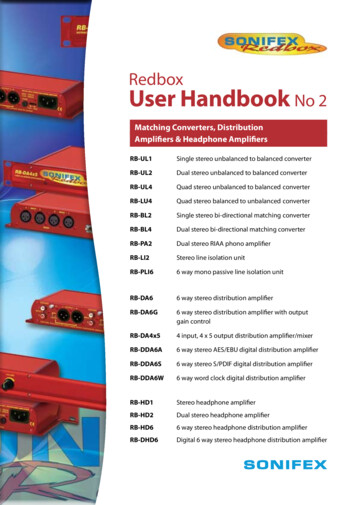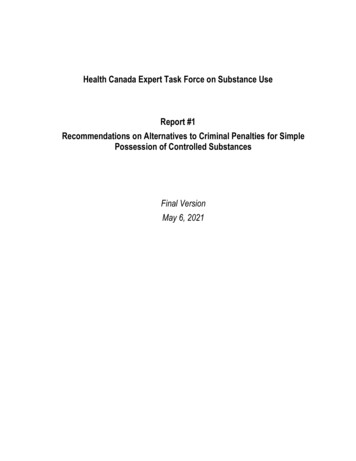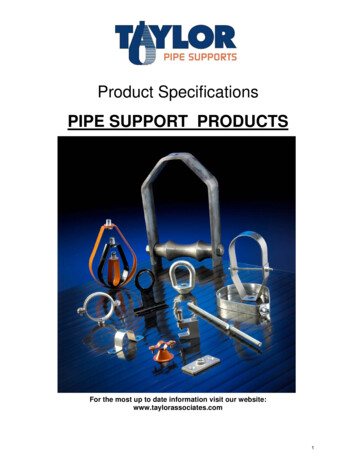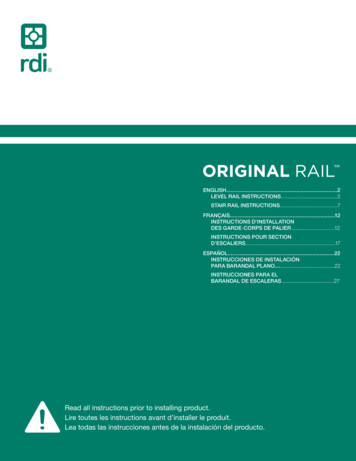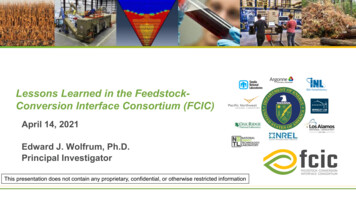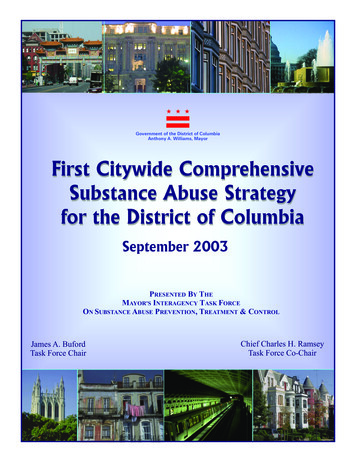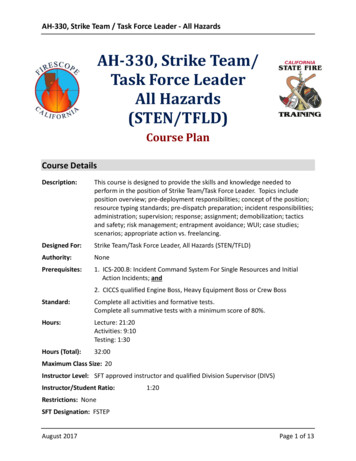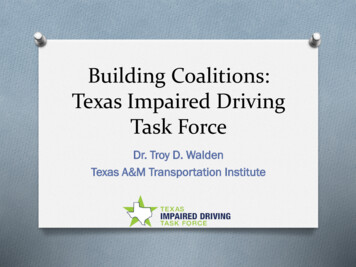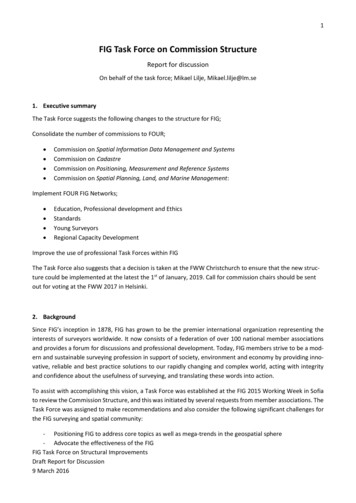
Transcription
1FIG Task Force on Commission StructureReport for discussionOn behalf of the task force; Mikael Lilje, Mikael.lilje@lm.se1. Executive summaryThe Task Force suggests the following changes to the structure for FIG;Consolidate the number of commissions to FOUR; Commission on Spatial Information Data Management and SystemsCommission on CadastreCommission on Positioning, Measurement and Reference SystemsCommission on Spatial Planning, Land, and Marine Management:Implement FOUR FIG Networks; Education, Professional development and EthicsStandardsYoung SurveyorsRegional Capacity DevelopmentImprove the use of professional Task Forces within FIGThe Task Force also suggests that a decision is taken at the FWW Christchurch to ensure that the new structure could be implemented at the latest the 1st of January, 2019. Call for commission chairs should be sentout for voting at the FWW 2017 in Helsinki.2. BackgroundSince FIG’s inception in 1878, FIG has grown to be the premier international organization representing theinterests of surveyors worldwide. It now consists of a federation of over 100 national member associationsand provides a forum for discussions and professional development. Today, FIG members strive to be a modern and sustainable surveying profession in support of society, environment and economy by providing innovative, reliable and best practice solutions to our rapidly changing and complex world, acting with integrityand confidence about the usefulness of surveying, and translating these words into action.To assist with accomplishing this vision, a Task Force was established at the FIG 2015 Working Week in Sofiato review the Commission Structure, and this was initiated by several requests from member associations. TheTask Force was assigned to make recommendations and also consider the following significant challenges forthe FIG surveying and spatial community:- Positioning FIG to address core topics as well as mega-trends in the geospatial sphere- Advocate the effectiveness of the FIGFIG Task Force on Structural ImprovementsDraft Report for Discussion9 March 2016
2-Effectively communicate FIG activities to members and partnersGrow the number of FIG contributors and promote the productiveness of CommissionsEnsure equitable and adequate participation at FIG meetings and within the CommissionsEnhance the representation of member associations, the private sector and young surveyorsObtain positive economical results where choice of venue of FIG Working Week is of most importance.Identify how the FIG will be a long term active partner in the developing world.As a consequence of submissions to the General Assembly, the remit of the Task Force was to initially review:-the current structure of the FIG,the FIG’s terms of reference,the mission of the FIG Commissionsthe current processes involved with assessing and selecting qualified candidates to CommissionChairsmake recommendations regarding the above, as well as provide a definition of the challenge, the levelof adaptation/change required, and suggest ideas on how to improve the capability of FIG and theCommissions to accomplish the work plans.3. Drivers for ChangeThe role and contribution of the surveyors has transformed heavily if we consider societal, economic, environmental and technological changes over time. FIG has tried to adapt to these changes however the rate atwhich change has occurred has been more rapid over the last few decades. During this period, surveyors havetruly undergone a massive progression, and FIG as an organisation must progress alongside the profession.Technologically, the profession has been impacted in both the way we work, and the way we communicateand organise. Social media influences the rapidity with which knowledge spreads, and the reach of the audience. Similar technological advancements have enabled the survey profession to change the way informationis collected, stored, integrated and distributed. Information is now gathered in huge quantities, is becomingmore accessible, exchangeable, and on platforms or via media that were not even considered when the current Commission structure was decided. It is important that we manage and acknowledge these advancements and their impact on FIG’s modes of operation.Growing from the growth and accessibility of technology, FIG is further seeing an increasing role to play inadvising on the social, environmental and economic challenges faced by decision makers from both developedand emerging countries. For examples addressing global issues and emerging “mega trends” related to genderequity for women’s access to land and education; poverty, sustainable land development; climate change; andurbanisation. These mega trends are in part driving the linkages FIG is forging with multinational organisationssuch as the United Nations, the scientific and academic community and the operational professional surveyor.To manage these social, economic and technological advances, changes and challenges, FIG must be a moreefficient and effective organisation in the future. FIG must be proactive in identifying the mega trends thatsociety is presently facing and likely to face in the future, and thus decide how FIG should be challenging thesemega trends. FIG needs to be aware of its role on the international stage, whilst still supporting the core ofFIG Task Force on Structural ImprovementsDraft Report for Discussion9 March 2016
3the profession. Questions on the responsibilities of the FIG should be considered not only by the FIG Councilbut also to the Commissions themselves and our member associations: Can these roles and others be actively dealt with relation to the internal and Commission structure ofFIG?What role does FIG want to play in the future?What is our vision?These questions go to the heart of the structure of the Commissions, which provide the structure to enablethe FIG to face future changes and challenges. They go above and beyond the role of this Task Force, butprovide an important foundation. Therefore, this Task Force examines the internal structure of the organisation and suggest changes if there is a need to restructure the Commissions to support our surveyors.4. Working MethodAs previously mentioned, the Task Force was officially formed at the General Assembly convened in Sofia, May2015 during the FIG Working Week. Since then, the Task Force has held physical meetings, internet based ones(e.g. through Skype) and also many email discussions. From these interactions, the Task Force has determinedthat it will be responsible for:-Recommending changes to the Commission structure which may also include the number, type, composition and work of Commissions.Suggesting alterations with Commissions with respect to the allocation of work, FIG leadership, member association participation and general achievement.Identifying possible strategies to optimize FIG Council, Commission Chair and member activities without significant change to FIG processes.Providing a broad range of recommendations for further reviewAt this stage the Task Force has decided that it will not address:-Changes to the Definition of the Functions of the SurveyorReview of official strategies or documentsWe consider that, although the Vision and Work Plan of the FIG / FIG Council could be more specific andprovide direction to and harmonization across the Commissions, in their current forms they are flexibleenough to provide guidance but to ultimately allow Commission Chairs the necessary freedom to develop theirown work plans. We suggest a future review could consider the FIG Vision in the context of this review andidentified challenges, and/or the needs of the Commission Chairs and FIG members with relation to the FIGVision and Council Work Plan.Hence, the Task Force will not suggest changes to the present FIG Vision, role, function and definition of theSurveyor, however if deemed necessary alterations to these statements will be recommended to support anystructural modifications to the Commissions. In the same manner the Task Force will not discuss current FIGstrategies or work plan documents, unless they affect structural change.The Task Force members are as follows: Mikael Lilje (chair), Brian Coutts (New Zealand), Stephen Djaba(Ghana), Henning Elmström (Denmark), Kate Fairlie (Australia), Brent Jones (USA), Jürg Kaufmann (Switzerland), Hansjörg Kutterer (Germany), Robert Sarib (Australia), Winnie Shiu (China), Rudolf Staiger (Germany),FIG Task Force on Structural ImprovementsDraft Report for Discussion9 March 2016
4Karl-Friedrich Thöne (Germany). The Task Force will also utilize other selected FIG members as a referencegroup to gather invaluable feedback and critical analysis.5. Summary of the Review of FIG Commission structureThe Task Force has reviewed the current situation and has formulated the following matrix. It some cases theanalysis covers more than just Commissions structure due to the nature of Commission work and its roles inthe FIG organisation. Consequently, to have an efficient Commission demands that the environment underwhich they operate justifies this.Area of challengeCommissionProblem-Lack of interaction betweenCommissionsVarying size of CommissionsAchievement levels of CommissionsRecommendation--Social mediaOverlap/communication withother fields/organisations-Member Associations--Private sector-Justifying membershipPromoting visibility of surveying(declining membership)Struggles to see value in FIGCommunication--Events-Engagement vs.participation-Cost of attendingInclusion of Asia Pacific/Africa/AmericasCatering to existing vs. ‘potential’ membersEg. FIG YSN has reached 5000 BUT struggles with participation, how to make this easy?Focus on voting for individualsvs. agendaFIG Task Force on Structural ImprovementsDraft Report for Discussion9 March 2016--Streamline CommissionsCreate more flexible TaskForce structure (enable 2and 4- year engagements?)Election changes, determined by CommissionsACCO rep to come from VPinstead of Commissions?Develop communicationstrategy for FIGReview databases (resources)Identify value adds in addition to meetingsStrategy to directly addressprivate sectorCloser ties between privatesector and CommissionsSingle cooperate sponsorpayment, rather than perevent
56. Proposal for new Commission Structure including Task Forces and NetworksGiven the possibility to suggest changes and given the discussions the Task Force has had regarding the number of current commissions and the mega trends we suggest rationalising the number of Commissions andencourage FIG to be more flexible regarding Task Forces as well as raise the awareness and profile of Networks.We believe by doing this, FIG would become more suitably organised to address the major challenges that weare noticing, improve the internal communication and be a more flexible and effective organisation. We believe also that it would be easier to recruit officers to the positions since there is a fewer number, and moreimportantly facilitate innovation through a mixed team environment.The suggestion from the Task Force is to organise the structure in the following four (4) commissions; Commission on Spatial Information Data Management and Systems (Basically Commission 3 andCommission 10 but needs to be more focused than current Commission 3)Commission on Cadastre: Legal basics of land and water, property, administration, valuation and management (Basically current commission 7 but also Commission 4)Commission on Positioning, Measurement and Reference Systems: Location techniques and instruments for all sorts of spatial objects (Basically Commission 5 and 6 but also part of Commission 4 and10)Commission on Spatial Planning, Land and Marine Management: (Basically Commission 4, 8, 9 and10)We have also noted the importance that our FIG Networks do have and suggest that their role and importanceare highlighted within the FIG organisation. We also noted that the current Commission 1 and 2 are dealingwith our profession and that they do cover more or less all current commissions. In our view, they are anFIG Task Force on Structural ImprovementsDraft Report for Discussion9 March 2016
6established Network rather than a focused Commission. We suggest the following four FIG Networks be implemented; Education, Professional development and EthicsStandardsYoung SurveyorsRegional Capacity DevelopmentProfessional Task Forces are to deal with contemporary and interesting issues established by the Council atthe request of the ACCO. Professional Task Forces take care of emerging issues of the societies, e.g.: Energy transitionClimate changeLand grabbingRapid urbanisationPoverty reductionRegional DevelopmentOtherWith this arrangement, the Commissions can focus on the development of the core skills of the profession andensure that the associated behaviour and the necessary education is concentrated on a good and sound professional expertise. Commission Chairs are no longer compelled to take superficial or otherwise ambiguoustopics into their work plan, but to rather provide advice to the Council and the members to prepare the professional surveyor for the future.The Professional Task Forces shall carry out fundamental studies about emerging issues and should exist for alimited time. The outcomes determined by these Task Forces can deliver their findings to the Commissionswho can then assess the impacts on the professional expertise and the professional development. Greateremphasis on the TF will best enable cross-Commission work, will help to build a solid base of expertise forfuture FIG leadership and will enable more flexible approaches to mega trends. Critically, they will address acurrent gap in FIG, which is the lack of short-term and mid-level leadership positions which particularly limityoung surveyor contributions.The profile of the Networks should be larger within FIG and they should work across the Commission structure.There should also be a direct link through personal resources between the Networks and the Commissions.Again, this acknowledged partnership should foster additional mid-level leadership roles to promote a pathway to greater engagement within FIG.The formal process of recruiting Commission chairs and officers will be less onerous under the above approach. It is our suggestion that the Steering Committee of each Commission should include (at least) theChair, the Vice Chair of Administration, the Working Group Chairs as well as one young surveyor, to ensurethat the large workload of the FIG does not simply fall on fewer shoulders – and further work will be necessaryto address this. Fewer Commissions will additionally contribute to a small reduction in FIG running costs. Therisk to have inappropriate Commission officers is reduced. Risk of overlapping work plan issues is minimized.However, FIG must still be aware of these issues and work accordingly to avoid implications in the future.FIG Task Force on Structural ImprovementsDraft Report for Discussion9 March 2016
7Improve the selection process for Commission ChairsRegarding the process of identifying new Commission Chairs, the internal rules 11.4 state that “a nomineeshall preferably have played an active part in the activities of the commission for which he or she is beingnominated as chair, and shall have demonstrated possession of the personal and professional capabilitiesneeded to lead the work of the commission. In addition, the Council shall assure itself as to the nominees’practical availability for service and that they have sufficient financial and administrative support.”The Task Force suggests that for the Commission Chairs Elect, the existing Commission officers should also beinvolved in the assessment of the candidate. The Commission has the possibility to actively suggest candidatesas Commission Chairs but the candidate’s Member Association must always support the nomination. The Commission (and Member Associations) should also evaluate the candidates to make sure that she/he is able tofulfill the job, and has the required experience of FIG to understand the position. The Commissions are one ofthe key “bodies” that have sufficient knowledge of their members and who are able to judge their FIG eligibility, subsequently Commissions should have the ability to also negotiate with the Member Association of thecandidate they wish to nominate. The Task Force also suggests that more than one Commission should not bechaired by two representatives from the same Member Association.The Task Force, also recommend that when there is more than one candidate for the position of CommissionChair, then a “selection panel” may be established (comprising of ACCO and / or the Council representativesand Commission Chairs) and be given the option and opportunity to indicate to the General Assembly whomay be a more suitable Commission Chair.7. In Depth Analysis and Evaluation of FIG Commission Structure7.1Vision, Role, Theme and Organisation of FIGAccording to website (www.fig.net), the FIG Vision is as follows;A modern and sustainable surveying profession in support of society, environment and economy by providinginnovative, reliable and best practice solutions to our rapidly changing and complex world, acting with integrityand confidence about the usefulness of surveying, and translating these words into action.During the deliberations of the Task Force it became apparent that the FIG Vision does not suggest or foreseewhat the future composition of the Commissions should be. After consideration, this finding has both a positive and a negative side. The positive aspect is that the present vision does not mention “internal structuralrequirements” thus this provides flexibility for FIG to create an internal structure to achieve the vision andobjectives. The negative side however is that the vision does not accommodate “mega trends” and specificallythe role that surveyors can play.In other words - The Task Force recommends consideration be given to altering the FIG Vision to includewords relating to “mega trends” and that surveyors have a role to play.According to the webpage the present role and theme of FIG is;FIG Task Force on Structural ImprovementsDraft Report for Discussion9 March 2016
8FIG’s activities are governed by a work plan, which is approved by the General Assembly and reviewed byCouncil as its tenure progresses. The current work plan with the motto “Ensuring the Rapid Response to ChangeEnsuring the Surveyor of Tomorrow” guides Council, Commissions, Networks and Task Force in their activities.FIG supports the role of a prosperous and sustainable profession of surveyors to provide solution functionality,reliably, affordably for a complex and rapidly changing world that cannot wait, and to translate a sustainabledevelopment agenda into action. FIG supports international collaboration among its members for the progressof surveying in all its fields and applications. FIG has a close cooperation with United Nations relevant bodies,World Bank, and its sister associations and has been globally recognized as the leading international non-governmental organization on geospatial information and the management of “land”, the “sea” and the “built”environment. It is within the surveyors’ task to determine the size and shape of the earth, to map its surfaceand to manage it in a sustainable way.This statement about the role of FIG is appropriate. To be successful in the future, FIG must remain an activeimportant player on the international scene, ready to interact, ready to collaborative, ready to deliver andready to contribute.7.2Organization of FIGThe position of the Commissions within the FIG Organization is defined in the organizational chart publishedon the FIG homepage:In view of Commissions the FIG homepage states:FIG’s technical work is led by ten Commissions. The responsibilities and work plans of Commissions are approved by the General Assembly during the FIG Congress. The work of each Commission is led by the Chairperson – elected for four-year term of office by the General Assembly at the Congress. The Chair is assisted by theCommission Vice-Chairpersons also appointed by the General Assembly. The Chair-Elect is elected by the General Assembly two years before the Congress. The Commission Chair is also assisted by a Vice-Chair of Administration who is in charge for the administration of the Commission. Every Commission has established at leastthree working groups on special topics. All member associations have the right to nominate a national delegateto each of the ten Commissions. The affiliates, academic members and corporate members have a right tonominate a correspondent to each Commission. The responsibilities and privileges of national delegates arepublished in the Internal Rules.The statutory regulations create the organizational framework for the Commissions and their work. There areno official documents or rules that define or specify neither the number nor the Terms of Reference (ToR) ofthe Commissions. Decisions relating to such matters are approved by the General Assembly. It appears theonly rule concerning the content of the Commission work is given in item 11.1 of the Internal Rules:Commissions shall be established to further the technical and professional work of the Federation. Betweenthem they shall cover all the activities listed in the definition of a surveyor.FIG Task Force on Structural ImprovementsDraft Report for Discussion9 March 2016
9Note - the FIG definition of the “surveyor” can be found in Appendix C.In other words - The Task Force recommends that the FIG Council need to ensure that all activities (as listedin the definition of s surveyor) are addressed by the Commission work plans.7.3Internal RulesChapter 11 of the FIG Internal Rules deals with Commissions, and an extract of the relevant internal rules canbe found in Appendix A.7.4The Relevance of CommissionsAccording to the Internal Rules, FIG establishes Commissions to further the technical and professional work ofthe Federation. It is also stated that their work plans shall be decided by a vote of the General Assembly. It isnot stated, and should not be stated either, how FIG ensure that the Commissions anticipate and respond tomarket trends and client demands.Overall there appears to be very little information on the webpage and within FIG documents on the benefits,relevance, and opportunities to the members regarding the Commissions and their work. For those who havebeen involved in FIG for many years use the Commissions as a forum to meet other persons working in thesame field or discipline. This interaction allows the exchange of ideas, thoughts and best practice. It is also avehicle to build and expand one’s personal and professional network.In other words - The Task Force recommend that FIG create an official statement regarding the benefits andresults of active participation in Commissions to members and FIG respectively.7.5Responsibilities of Commission ChairsThe roles and responsibilities of Commission Chairs are described in a special document endorsed by the General Assembly in 2008. A copy can also be found in Appendix B. The Task Force agree with the listed roles andresponsibilities; however it should be a requirement that new Commission Chairs engage with each other todiscuss and review their proposed work plans. This means, time needs to be set aside so that the new Chairscan identify possible collaboration on related issues / challenges and outcomes, and the sharing of resourcesbefore they are endorsed by the General Assembly. This will also display to the General Assembly synergy andharmonisation between Commissions with respect to achieving the FIG Vision.In other words - The Task Force recommends that new Commission Chairs must discuss and review theirproposed plans with each other so as to identify possible collaboration on related issues / challenges andoutcomes and demonstrate synergy amongst their work plans with respect to achieving the FIG Vision.7.6FIG Task ForcesBesides the Commissions, FIG maintains a series of Task Forces to carry out special tasks. Item 13 of the Internal Rules state:Task Forces may be established by the Council to research and to advice on matters of an administrative or ofa general policy nature. They will normally be of short duration and will be concluded on the presentation andacceptance of their reports by the Council and, where necessary, the General Assembly. Their composition,chairs, terms of reference and work plans shall be approved by the Council.FIG Task Force on Structural ImprovementsDraft Report for Discussion9 March 2016
10The advantage of using Task Forces is that it provides FIG the flexibility to focus on a specific subject for alimited amount of time regardless of the time in relation to the 4 year term, FIG Congresses, the timeline forCommission works, its work plans and coming work plans. The Task Force believe that FIG is not using thisopportunity as much as it should. For example FIG should be considering the use of Task Forces to discusschallenges in the context of digitalisation, mega cities, urbanisation and more.In other words - The Task Force recommends that FIG Council should consider the use of more Task Forcesto address significant challenges.7.7Functions of the current CommissionsRegarding the role of the commissions, FIG states that “the commissions, under the guidance of their chairs,are responsible for pursuing FIG’s professional and technical objectives, through the implementation of workplans that are adopted by the General Assembly following the FIG Congress and culminate with the delivery oftechnical programmes at the following congress.”It is up to General Assembly to decide and approve changes to the FIG Commission structure. Going throughthe terms of reference as well as missions of the current Commissions it is not easy to find any Commissionthat actively looks into the future of FIG. The Commissions are very much focused on the current four yearperiod and this is understandable, but it is obvious FIG is missing mechanisms that will allow the FIG to addressthe modern challenges of “the mega trends” and for its internal structure to act accordingly. As a consequence,the Task Force propose that there should be “structured and formalised” cross-Commission workshops duringthe period from when the Chair-Elects are elected (two years before a Congress) to when the new Commissionwork plans are approved (normally at the “first GA” after the new Commission Chairs are in place). Theseworkshops should identify and monitor issues or topics relating to “mega trends”, and then make amendmentsto their proposed Commission work plans, mission and objectives. This process should be overseen by FIGCouncil and / or ACCO and this will also ensure that FIG’s vision or strategy is incorporated in Commission workplans.Commissions 1 and 2 deal with the surveyor profession in general. The Task Force has called them Inter-Commissions since they are very much FIG internal and not having the outside-in focus. They are also interdisciplinary, as their mission or work should be influenced or based on the findings or outcomes from the more technical-oriented Commissions.The other Commissions have topics of interest for a specific sector of the FIG members. For example - Commissions 3 to 5 treat mainly technical aspects and tools, Commissions 6, 7 and 8 are occupied with the application of these tools, and Commission 9 and 10 take care of the valuation and economic aspects of land andconstructions. Generally, the Commissions have been stable for many years even though their terms of references and missions may have been developed. The Terms of References of some Commissions are heterogeneous and do not carry the same level of relevance. It is apparent that FIG needs to be more active in thepreparation of Commission work plans so that objectives do not overlap or have a gap.Potential synergies in work plans can be seen from their denominations:Commission1NameProfessional Standards and PracticeFIG Task Force on Structural ImprovementsDraft Report for Discussion9 March 2016
112Professional Education3Spatial Information Management4Hydrography5Positioning and Measurement6Engineering Surveys7Cadastre and Land Management8Spatial planning and development9Valuation and the Management of Real Estate10Construction Economics and ManagementIn other words - to avoid duplication of effort or to improve the use of resources, Commissions should harmonise their work plans. For example, Commission 1 and 2 should define their actions on developmentsoutlined by the other Commissions and to formulate conclusions for the development of the profession andthe education of the professionals.7.8Free choice of Commission topicsIt appears the tradition within FIG is to give the Commission Chairs-elect the freedom to develop their ownwork plans. In most cases, they do their best but the drivers for the choice or content are often not wellconsidered nor take into account the FIG Vision or Strategy. Normally, the work plan objectives are the resultof the Commission Chair-elect’s own focus areas and not the global professional surveyor challenges such asthe “mega trends”. The Commission Chair-elects tend to focus on ’burning issues’ when preparing the workplans, and as a consequence the long term mission of FIG is not taken into account as much as it should. Thereshould of course always be freedom for the Commissions to develop their own work plans but the FIG organisation should also have a stronger mechanism to ensure that work plans are homogenous and cover the entireFIG surveyor and are part of the Strategy and Vision.FIG needs to have insights into the future developments of the profession as well as the mega trend. FIG needsto be focused and clear on the position that the organisation would like to have in the future. Be
The Task Force suggests the following changes to the structure for FIG; Consolidate the number of commission s to FOUR; Commission on Spatial Information Data Management and Systems Commission on Cadastre Commission on Positioning, Measurement and Reference Systems Commission on Spatial Planning, Land, and Marine Management:

